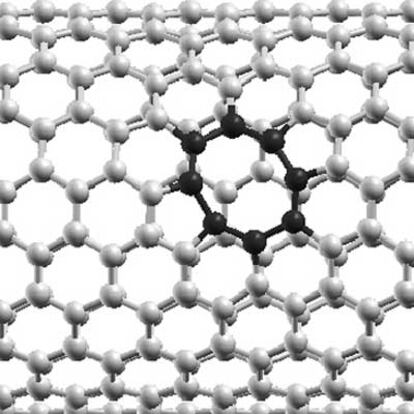Beyond ordinary matter
Each atom is not indivisible as its Greek name suggests; instead, each atom is made of a cloud of electrons around nuclei, which are small spheres with diameters of a millionth of a billionth of a meter. Nuclei are, in turn, made of a number of protons and neutrons bound by a force (called the strong force) that is much more intense than the electromagnetic one. While electrons are elementary particles, protons and neutrons are themselves made of three quarks each. Quarks behave as elementary particles and are, together with the electrons, the actual building blocks of ordinary matter.
Again, this is not a revelation; this overall picture was first understood by physicists in the mid-sixties. Nonetheless, a careful reader might notice a weird pattern here?while there is no constraint on the number of electrons and protons or neutrons in ordinary matter, quarks only exist in groups of three.
Why is this so? Do objects with a different number of quarks exist in nature and if so, what do they look like?
First, quarks cannot exist individually; because their strong interactions are so intense, they can only exist in states where there are several quarks that mutually screen their interaction potential. This effect is known as confinement. Defining a strong charge analogous to the electric one, we can say that only states with zero strong charge can be observed.
Confinement allows states composed of a quark and the corresponding particle with a charge of the opposite sign, called anti-quark. Unfortunately, pairs of particles and anti-particles are very likely to annihilate and transform into something different. Therefore, particles made of a quark and an anti-quark, called mesons, live for a very short time before decaying. They cannot exist in ordinary matter, but are produced in high-energy collisions, such as when particles from the universe impact the atmosphere, or in laboratory accelerators.
What about states with more than three constituents? Do they exist, and do they play any role in ordinary matter? Nothing prevents the existence of states with two quarks and two anti-quarks, called tetra-quarks, but they have not yet been observed. The more quarks are present in a state, the earlier it decays and the higher its mass. This means that observing tetra-quarks requires a large accumulation of energy (which is proportional to the mass) and detectors capable of reconstructing particles from their decay products. This is why the first candidates for such states were observed accidentally in huge experiments that were built for entirely different research purposes?the BaBar experiment at the Stanford Linear Accelerator Center in California and the Belle experiment at KEK in Japan, which are several metre tall detectors sitting in the interaction points of accelerators several kilometres long. They were built to make precision measurements of the decay of B mesons, but ended up also producing a large number of tetra-quarks. Everything started in 2004 when BaBar observed a state, called Ds(2317), with mass and decay properties not expected for any known quark aggregate. This was an indication of an anomaly in the quark content of this state. In the following years, the two experiments made several discoveries of the same kind, until the most recent and striking evidence: the observation from Belle in 2008 of charged states decaying into bound states of a charm and anti-charm quark. These states, if confirmed, have no explanation other than a four-quark composition, and would represent a certain proof of this new form of matter.
What next? Observation of this new class of particles is critical to complete the picture of strong interactions and confirm our understanding of matter. But we only see a very fragmented picture, as when we had just a handful of chemical elements of the periodic table, but believed all the others to exist. By interpreting the current observations, theoretical models can predict a large number of other states, with different characteristics, depending on the model.
Experiments where a larger number of tetra-quarks are produced are therefore needed, both to confirm the present evidence and, more importantly, to build a complete picture. Only a systematic investigation of the field can discriminate among the models, and the next generation of accelerators, such as the LHC at the CERN of Geneva (Switzerland) or the SuperB in Frascati (Italy) have included this among their goals.
Riccardo Faccini, University of Rome La Sapienza. www.atomiumculture.eu

Tu suscripción se está usando en otro dispositivo
¿Quieres añadir otro usuario a tu suscripción?
Si continúas leyendo en este dispositivo, no se podrá leer en el otro.
FlechaTu suscripción se está usando en otro dispositivo y solo puedes acceder a EL PAÍS desde un dispositivo a la vez.
Si quieres compartir tu cuenta, cambia tu suscripción a la modalidad Premium, así podrás añadir otro usuario. Cada uno accederá con su propia cuenta de email, lo que os permitirá personalizar vuestra experiencia en EL PAÍS.
¿Tienes una suscripción de empresa? Accede aquí para contratar más cuentas.
En el caso de no saber quién está usando tu cuenta, te recomendamos cambiar tu contraseña aquí.
Si decides continuar compartiendo tu cuenta, este mensaje se mostrará en tu dispositivo y en el de la otra persona que está usando tu cuenta de forma indefinida, afectando a tu experiencia de lectura. Puedes consultar aquí los términos y condiciones de la suscripción digital.




























































